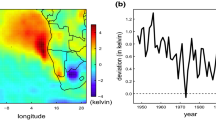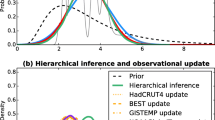Abstract
Coupled atmosphere–ocean general circulation models are key tools to investigate climate dynamics and the climatic response to external forcings, to predict climate evolution and to generate future climate projections. Current general circulation models are, however, undisputedly affected by substantial systematic errors in their outputs compared to observations. The assessment of these so-called biases, both individually and collectively, is crucial for the models’ evaluation prior to their predictive use. We present a Bayesian hierarchical model for a unified assessment of spatially referenced climate model biases in a multi-model framework. A key feature of our approach is that the model quantifies an overall common bias that is obtained by synthesizing bias across the different climate models in the ensemble, further determining the contribution of each model to the overall bias. Moreover, we determine model-specific individual bias components by characterizing them as non-stationary spatial fields. The approach is illustrated based on the case of near-surface air temperature bias in the tropical Atlantic and bordering regions from a multi-model ensemble of historical simulations from the fifth phase of the Coupled Model Intercomparison Project. The results demonstrate the improved quantification of the bias and interpretative advantages allowed by the posterior distributions derived from the proposed Bayesian hierarchical framework, whose generality favors its broader application within climate model assessment.








Similar content being viewed by others
References
Banerjee S, Carlin BP, Gelfand AE (2014) Hierarchical modeling and analysis for spatial data. CRC Press, New York
Berliner LM (2003) Physical-statistical modeling in geophysics. J Geophys Res Atmos 108:8776. doi:10.1029/2002JD002865
Boberg F, Christensen JH (2012) Overestimation of Mediterranean summer temperature projections due to model deficiencies. Nat Clim Change 2:433–436
Brohan P, Kennedy JJ, Harris I, Tett SF, Jones PD (2006) Uncertainty estimates in regional and global observed temperature changes: a new data set from 1850. J Geophys Res Atmos. doi:10.1029/2005JD006548
Buser CM, Knsch HR, Lthi D, Wild M, Schr C (2009) Bayesian multi-model projection of climate: bias assumptions and interannual variability. Clim Dyn 33:849–868
Christensen JH, Boberg F, Christensen OB, LucasPicher P (2008) On the need for bias correction of regional climate change projections of temperature and precipitation. Geophys Res Lett. doi:10.1029/2008GL035694
Cowles MK, Carlin BP (1996) Markov chain Monte Carlo convergence diagnostics: a comparative review. J Am Stat Assoc 91:883–904
Cressie N (1993) Statistics for spatial data. Wiley, New York
Flato G, Marotzke J, Abiodun B, Braconnot P, Chou SC, Collins W, Cox P, Driouech F, Emori S, Eyring V, Forest C, Gleckler P, Guilyardi E, Jakob C, Kattsov V, Reason C, Rummukainen M (2013) Evaluation of climate models. In: Stocker TF, Qin D, Plattner G-K, Tignor M, Allen SK, Boschung J, Nauels A, Xia Y, Bex V, Midgley PM (eds) Climate change 2013: the physical science basis. Contribution of Working Group I to the Fifth Assessment Report of the Intergovernmental Panel on climate change. Cambridge University Press, Cambridge, United Kingdom and New York, NY, USA
Furrer R, Sain SR, Nychka D, Meehl GA (2007) Multivariate Bayesian analysis of atmosphereocean general circulation models. Environ Ecol Stat 14:249–266
Gelfand AE, Diggle P, Fuentes M, Guttorp P (2010) Handbook of spatial statistics. Chapman and Hall / CRC, Florida
Gelman A (2006) Prior distributions for variance parameters in hierarchical models (comment on article by Browne and Draper). Bayesian Anal 1:515–534
Gelman A, Hill J (2006) Data analysis using regression and multilevel/hierarchical models. Cambridge University Press, Cambridge
Gilks WR, Richardson S, Spiegelhalter DJ (1996) Markov chain Monte Carlo in practice. Chapman and Hall, London
Higdon D (1998) A process-convolution approach to modelling temperatures in the North Atlantic Ocean. Environ Ecol Stat 5:173–190
Jun M, Knutti R, Nychka DW (2008) Spatial analysis to quantify numerical model bias and dependence: how many climate models are there? J Am Stat Assoc 103:934–947
Kalnay E, Kanamitsu M, Kistler R, Collins W, Deaven D, Gandin L, Iredell M, Saha S, White G, Woollen J, Zhu Y (1996) The NCEP/NCAR 40-year reanalysis project. Bull Am Meteorol Soc 77:437–471
Kang EL, Cressie N, Sain SR (2012) Combining outputs from the North American regional climate change assessment program by using a Bayesian hierarchical model. J R Stat Soc Ser C Appl Stat 61:291–313
Kaufman CG, Sain SR (2010) Bayesian functional ANOVA modeling using Gaussian process prior distributions. Bayesian Anal 5:123–149
Keller CF (2009) Global warming: a review of this mostly settled issue. Stoch Environ Res Risk Assess 23:643–676
Kistler R, Collins W, Saha S, White G, Woollen J, Kalnay E, Chelliah M, Ebisuzaki W, Kanamitsu M, Kousky V, van den Dool H (2001) The NCEP-NCAR 50-year reanalysis: monthly means CD-ROM and documentation. Bull Am Meteorol Soc 82:247–267
Knutti R (2010) The end of model democracy? An editorial comment. Clim Change 102:395–404
Lambert SJ, Boer GJ (2001) CMIP1 evaluation and intercomparison of coupled climate models. Clim Dyn 17:83–106
Leith NA, Chandler RE (2010) A framework for interpreting climate model outputs. J R Stat Soc Ser C Appl Stat 59:279–296
Milinski S, Bader J, Haak H, Siongco AC, Jungclaus JH (2016) High atmospheric horizontal resolution eliminates the wind-driven coastal warm bias in the southeastern tropical Atlantic. Geophys Res Lett (Accepted for publication)
Mugglin AS, Carlin BP (1998) Hierarchical modeling in geographic information systems: population interpolation over incompatible zones. J Agric Biol Environ Stat 3:111–130
Neuman SP (2003) Maximum likelihood Bayesian averaging of uncertain model predictions. Stoch Environ Res Risk Assess 17:291–305
O’Malley AJ, Zaslavsky AM (2008) Domain-level covariance analysis for multilevel survey data with structured nonresponse. J Am Stat Assoc 103:1405–1418
Polson NG, Scott JG (2012) On the half-Cauchy prior for a global scale parameter. Bayesian Anal 7:887–902
Sain SR, Furrer R (2010) Combining climate model output via model correlations. Stoch Environ Res Risk Assess 24:821–829
Stroud JR, Mller P, Sansó B (2001) Dynamic models for spatiotemporal data. J R Stat Soc Ser B Stat Methodol 63:673–689
Taylor KE, Stouffer RJ, Meehl GA (2012) An overview of CMIP5 and the experiment design. Bull Am Meteorol Soc 93:485–498
Tebaldi C, Smith RL, Nychka D, Mearns LO (2005) Quantifying uncertainty in projections of regional climate change: a Bayesian approach to the analysis of multimodel ensembles. J Clim 18:1524–1540
Toniazzo T, Woolnough S (2014) Development of warm SST errors in the southern tropical Atlantic in CMIP5 decadal hindcasts. Clim Dyn 43:2889–2913
Wahl S, Latif M, Park W, Keenlyside N (2015) On the tropical Atlantic SST warm bias in the Kiel Climate Model. Clim Dyn. doi:10.1007/s00382-009-0690-9
Wang C, Zhang L, Lee SK, Wu L, Mechoso CR (2014) A global perspective on CMIP5 climate model biases. Nat Clim Change 4:201–205
Zanchettin D, Bothe O, Lehner F, Ortega P, Raible CC, Swingedouw D (2015) Reconciling reconstructed and simulated features of the winter Pacific/North American pattern in the early 19th century. Clim Past 11:939–958
Acknowledgements
The research leading to these results has received funding from the European Union, Seventh Framework Programme (FP7/2007-2013) under Grant agreement no 603521—PREFACE. The authors would like to thank the two anonymous reviewers and the associate editor for helpful comments on the manuscript.
Author information
Authors and Affiliations
Corresponding author
Appendix: Choice of priors
Appendix: Choice of priors
In this section, we provide details of prior and hyperparamters choices. All priors are approximately non-informative. For the error variances \(\{\sigma ^2_{\varepsilon ,j}: j=1\dots , 6\}\), we assign the uniform prior on the standard deviation scale \(\sigma _{\varepsilon ,j}\sim \hbox {Unif}(a, b)\) by choosing \(a=0\) and \(b=10^2\) for each j independently. Accordingly, the error variances, which are proportional to \((b-a)^2\), are very large so that the priors are approximately non-informative. For \(\{\tau ^2_j: j=1\dots , 6\}\), we use a Half-Cauchy (HC) prior, which is a conditionally conjugate family of a half t distribution (Gelman 2006). The Half t distribution corresponds to the absolute value of a Student-t distribution centered at zero, whose probability distribution is proportional to
with two parameters: degrees of freedom \(\hbox {df}\) and scale parameter \(\theta\). We obtain the proper HC probability distribution for \(\tau _j\) as a special case of (8) by setting \(\hbox {df}=1\),
we specify priors for \(\tau _j\) as \(\tau _j\sim \hbox {HC}(\theta )\), independently for each j. Large but finite value of the scale parameter \(\theta\) represents an approximately non-informative prior distribution. In the limit \(\theta\) \(\rightarrow\) \(\infty\) this becomes a uniform prior density on \(p(\tau _j)\). For our analysis, we set \(\theta =30\). To choose a prior for the \(p\times p\) covariance matrix \(\mathbf{G}\), the variances \(G_1,\ldots , G_p\) and the pair-wise covariances \(G_{kl}:k,l=1,\ldots ,p\) must be explicitly specified. One way to achieve this is to use the separation technique (Gelman and Hill 2006; O’Malley and Zaslavsky 2008)
where \(\varGamma\) is the diagonal matrix with diagonal elements \(\omega ^2_1,\ldots , \omega ^2_p\) and \(\mathbf{Q}\) is new \(p \times p\) covariance matrix. The role of the new parameters \(\omega ^2_k\) and \(\mathbf{Q}\) is to derive appropriately scaled priors for the variances and pair-wise covariances related to \(\mathbf{G}\). We assign proper uniform prior on \(\omega ^2_k\sim \hbox {Unif}(0,10^{2})\) independently for each k. The covariance component \(\mathbf{Q}\) is given the inverse Wishart distribution \(\hbox {IW}(p+1,\mathbf{I}_p)\). The two parameters degrees of freedom \(p+1\) and the identity matrix \(\mathbf{I}_p\) fully determine the distribution. The variances and pair-wise covariances associated to \(\mathbf{G}\) are then obtained as \(G_k=\omega ^2_k Q_p\) and \(G_{kl}=\omega _k\omega _lQ_{kl}\). To make inference, we require the standard deviations \(|G_k|^{1/2}\) and correlations \(\rho _{kl}\)
Rights and permissions
About this article
Cite this article
Arisido, M.W., Gaetan, C., Zanchettin, D. et al. A Bayesian hierarchical approach for spatial analysis of climate model bias in multi-model ensembles. Stoch Environ Res Risk Assess 31, 2645–2657 (2017). https://doi.org/10.1007/s00477-017-1383-2
Published:
Issue Date:
DOI: https://doi.org/10.1007/s00477-017-1383-2




